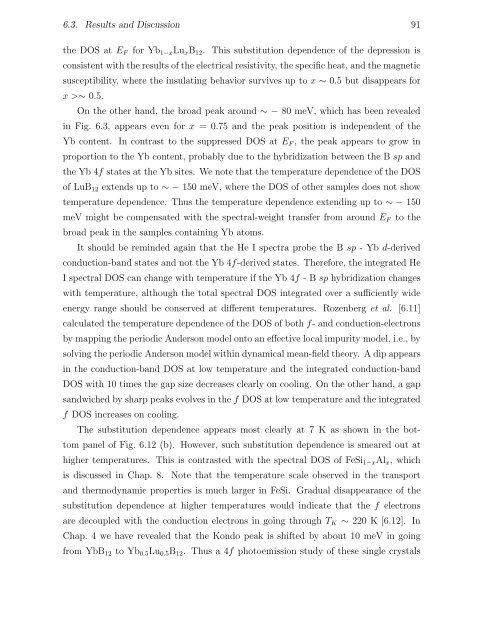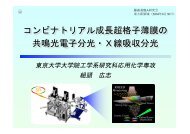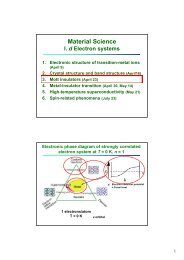Thesis High-Resolution Photoemission Study of Kondo Insulators ...
Thesis High-Resolution Photoemission Study of Kondo Insulators ...
Thesis High-Resolution Photoemission Study of Kondo Insulators ...
Create successful ePaper yourself
Turn your PDF publications into a flip-book with our unique Google optimized e-Paper software.
6.3. Results and Discussion 91<br />
the DOS at EF for Yb1−xLuxB12. This substitution dependence <strong>of</strong> the depression is<br />
consistent with the results <strong>of</strong> the electrical resistivity, the specific heat, and the magnetic<br />
susceptibility, where the insulating behavior survives up to x ∼ 0.5 but disappears for<br />
x>∼ 0.5.<br />
On the other hand, the broad peak around ∼−80 meV, which has been revealed<br />
in Fig. 6.3, appears even for x = 0.75 and the peak position is independent <strong>of</strong> the<br />
Yb content. In contrast to the suppressed DOS at EF , the peak appears to grow in<br />
proportion to the Yb content, probably due to the hybridization between the B sp and<br />
the Yb 4f states at the Yb sites. We note that the temperature dependence <strong>of</strong> the DOS<br />
<strong>of</strong> LuB12 extends up to ∼−150 meV, where the DOS <strong>of</strong> other samples does not show<br />
temperature dependence. Thus the temperature dependence extending up to ∼−150<br />
meV might be compensated with the spectral-weight transfer from around EF to the<br />
broad peak in the samples containing Yb atoms.<br />
It should be reminded again that the He I spectra probe the B sp -Ybd-derived<br />
conduction-band states and not the Yb 4f-derived states. Therefore, the integrated He<br />
I spectral DOS can change with temperature if the Yb 4f -Bsp hybridization changes<br />
with temperature, although the total spectral DOS integrated over a sufficiently wide<br />
energy range should be conserved at different temperatures. Rozenberg et al. [6.11]<br />
calculated the temperature dependence <strong>of</strong> the DOS <strong>of</strong> both f- and conduction-electrons<br />
by mapping the periodic Anderson model onto an effective local impurity model, i.e., by<br />
solving the periodic Anderson model within dynamical mean-field theory. A dip appears<br />
in the conduction-band DOS at low temperature and the integrated conduction-band<br />
DOS with 10 times the gap size decreases clearly on cooling. On the other hand, a gap<br />
sandwiched by sharp peaks evolves in the f DOS at low temperature and the integrated<br />
f DOS increases on cooling.<br />
The substitution dependence appears most clearly at 7 K as shown in the bottom<br />
panel <strong>of</strong> Fig. 6.12 (b). However, such substitution dependence is smeared out at<br />
higher temperatures. This is contrasted with the spectral DOS <strong>of</strong> FeSi1−xAlx, which<br />
is discussed in Chap. 8. Note that the temperature scale observed in the transport<br />
and thermodynamic properties is much larger in FeSi. Gradual disappearance <strong>of</strong> the<br />
substitution dependence at higher temperatures would indicate that the f electrons<br />
are decoupled with the conduction electrons in going through TK ∼ 220 K [6.12]. In<br />
Chap. 4 we have revealed that the <strong>Kondo</strong> peak is shifted by about 10 meV in going<br />
from YbB12 to Yb0.5Lu0.5B12. Thus a 4fphotoemission study <strong>of</strong> these single crystals






